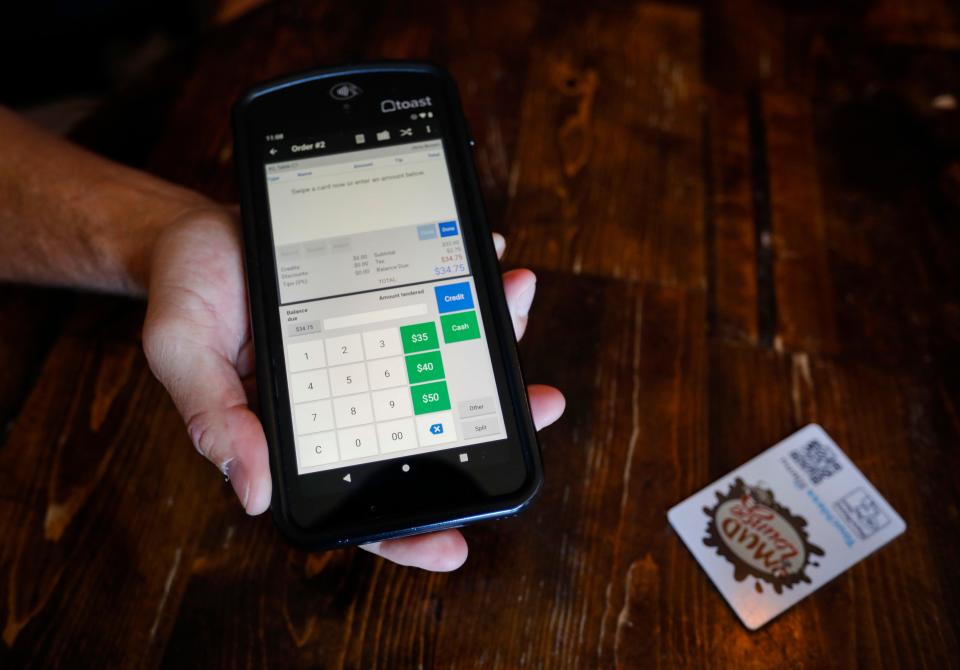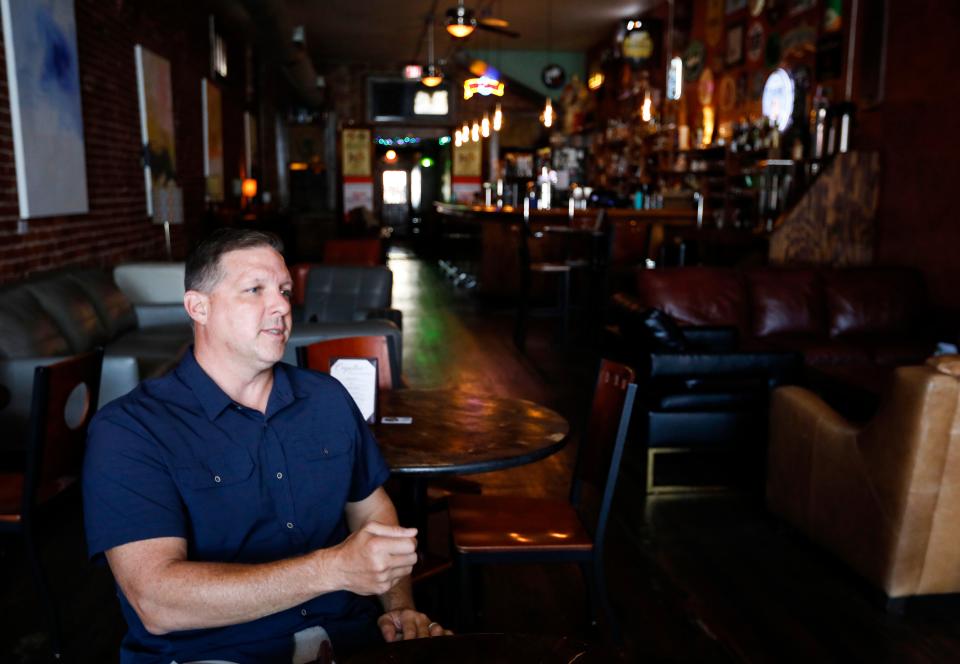Does it feel like everywhere you go, you're being asked to tip? Say hello to 'tipflation'
McKenna Stephens makes about $15 an hour as a barista at Starbucks but relies heavily on tips to help pay rent, purchase groceries and fill up her tank with gas.
Like many coffee shops, convenience stores and even fast food restaurants, Starbucks has implemented a digital point-of-sales system that prompts customers who pay with cards to leave a tip. At the Cherry Street and Glenstone Avenue location, where Stephens works — currently closed for renovations — customers are prompted to leave a $1, $2 or $5 tip. Customers may also choose to leave a "custom" tip or skip one entirely. Tips, cash and digital, are distributed among baristas at the end of each week, depending on how many hours each worked.
This new means of digital tipping has become increasingly popular since the height of the pandemic. The act of gratuity, traditionally associated with businesses like sit-down restaurants, salons and personal transportation, is seeping into other areas of the economy, in ways that can't be easily ignored.
In many cases, the passive appeal of a tip jar has been replaced by digital point-of-sale systems like Square and Toast that prompt customers directly, with options that include percentage-based tips (typically between 15-30%) or flat dollar amounts, like at Starbucks. This new phenomenon, dubbed "tipflation," is impacting businesses and consumers alike.
What is 'tipflation' and what caused it?
A combination of "tip" and "inflation," "tipflation" is the term that has been coined for the rapid increase in restaurants, cafes and retail stores implementing digital point-of-sale systems that prompt customers to select a gratuity while checking out, according to Forbes.
Jeffrey Jones, finance, economics and risk management department head at Missouri State University, said this new way of tipping proliferated during the COVID-19 pandemic.
"A lot of service workers, they couldn't work from home and so they were kind of viewed as being more at-risk, and so I think people felt very comfortable tipping extra just because of that fact," Jones said.
Additionally, more consumers were "flush with cash," Jones said. The combination of pandemic stimulus checks and constraints put on public activities, like travel, left some consumers with extra change in their pockets.
But the expectation to tip service workers, even those who get paid minimum wage or above, has lingered, even though pandemic restrictions and stimulus checks are a thing of the past and product prices are on the rise. With no immediate change in sight, Jones said folks may need to get used to this new normal.
"It may not change, ever, because I can ask (for a tip), but I think what you're seeing is folks are declining those (tipping) opportunities more so than they did two or three years ago," Jones said.
In the more than six months Stephens has worked at Starbucks, she's noticed that most customers choose to not leave a tip and those that do, typically leave $1.
"People won't pay attention, either. You have to kind of remind them a couple of times that they have to answer the question in order for their card to process," Stephens said. "I feel like people almost avoid looking at the screen so they don't have to tip."

Stephens said she "always" tips, at least 20%, whether she's at a sit-down restaurant or somewhere like a cafe, where she knows the employees are paid at least minimum wage.
"My personal opinion is, if you can't afford a $1 in tips, don't buy a drink," Stephens said. "I can't really afford it either, but I understand that those tips from my job help me to afford to live, so I don't want to (deprive) somebody of that."
Jones said he is more inclined to tip in "traditional" environments, where employees are paid a server's wage (typically less than minimum wage), rather than those where employees are making minimum wage or above.
Service workers may be benefiting from this new tipping trend, but Jones said he doesn't think it is a sustainable business model.
"It is probably unsustainable for entry-level service workers to make considerably above minimum wage in the long term," Jones said. "Eventually, businesses will replace this higher cost labor with technology. An example would be the service kiosks you now see in many fast food and fast casual-type restaurants."
Pre- and post-service tipping
Part of the shift that can be off-putting for customers is the timing of digital tipping.
Traditionally, tipping has been thought of as an act of gratuity that follows service, known as "post-service tipping." But in some instances, especially when digital point-of-sales systems are involved, customers are being asked to tip before they have received the product ordered. Known as "pre-service tipping," this is the case at Starbucks and several other coffeeshops and casual dining restaurants.
Pre-service tipping is also common when ordering food/drinks online or through an app. For example, when ordering from food delivery services like DoorDash, customers are prompted to leave the delivery driver a tip during payment, not after the food has been delivered. The Starbucks app functions the same way. When a customer places an order on the app to pick up in store, they are prompted to leave the baristas a tip.
While growing more popular with businesses, pre-service tipping doesn't appear to be winning over consumers.
In a study conducted for the Journal of Service Research in 2020, tips at two fresh-made juice and smoothie shops on the East Coast were tracked over a month. The shops operated exactly the same, except one shop asked for pre-service tips and the other asked for post-service tips.
Tips at the post-service shop were higher, averaging $1.58, compared to the shop that asked for pre-service tips, which averaged a 90-cent tip per order. The study also found that 31.9% of customers left no tip at the pre-service tip shop, compared to only 13.5% who didn't leave a tip at the post-service shop.
Tableside tipping
In addition to changes in when and where customers are being asked to tip, the act of tipping is becoming less private in many venues.
Still gaining traction in the United States, but slowly filtering in, is the concept of tableside tipping. In this scenario, servers use a wireless point-of-sale terminal to ring up and check out customers right at the table.
Rather than being able to add a tip and sign the check after the server walks away, or leave cash on the table, the customer must decide whether and how much to tip while the server stands waiting.
Downtown bar The MudLounge implemented tableside tipping right before the pandemic. The bar uses two of Toast's wireless point-of-sales terminals. Servers take customer orders on the devices, which are sent directly to the bar and/or kitchen, and then use the terminals to check out customers who pay with cards.

MudLounge co-owner Chris Brown said the main reason for implementing tableside tipping at the bar was to cut down on the number of steps it takes for a server to help each customer.
"If somebody has a credit card, every time you put an order in you got to go back to the POS system and every time somebody wants their check, you bring them their check, you walk away and then you walk back, get their credit card, go to the POS, swipe it, bring it back to them and then you have to pick it up," Brown explained. "You're looking at like six different times that you're going back and forth to the POS system for one customer."
"Essentially, we thought it would be a lot faster ... we'd be able to ring drinks in faster and increase our sales by just minimizing the number of steps they (servers) took per order," Brown added.

Initially, during the first few months of implementation, servers were making about 4-5% more in tips per night using the handheld terminals, Brown said.
Ross Borgemeyer, a server and bartender at MudLounge, said overall, he's noticed an increase in tips on larger checks but a reduction in smaller tips. He thinks this is because the terminals prompt customers to leave percentage-based tips, where before they might have rounded up to whole dollars.
Influx of automatic gratuity service charges
More businesses are adding automatic gratuity service charges, as well.
These charges, typically a set dollar amount or percentage added to customer checks. Customers are still encouraged to leave a tip, but if they don't, the idea is that at least the employee is receiving appropriate hourly pay.
Gratuity service charges aren't a new concept. At most sit-down restaurants, gratuity service charges are added to checks for large parties. But some businesses are implementing them in other situations, too.
Alamo Drafthouse Cinema is one. The up-scale movie theater chain now adds an 18% gratuity service charge to all customer checks when food is ordered.
Springfield communications director Jen Johnmeyer said 100% of the gratuity service charge goes to the theater's staff. She could not answer when or why the charge was implemented.
Who's tipping more?
No matter how or where they are being tipped, Springfield service workers tend to agree about who the best tippers tend to be, with millennials (ages 27-42) and Gen Xers (ages 43-58) taking the prize.
Lauren Paige, a server and bartender at Storming Crab Seafood, said Gen X customers tip the best, with diners in their 20s also tending to be fairly reliable. She said older customers tend to order smaller, cheaper meals and leave less of a tip.
Lizzie Concannon, a server at Cafe Basilico, said in the year she's worked at the Commercial Street restaurant, she regularly receives the highest tips from millennials and Gen Xers. She added that customers who work or have worked in the service industry also tend to stand out.
"I can always tell what customers have worked in customer service or not by the way they tip and pre-bus (clean up) tables," Concannon said.
Those local observations are more or less in line with national trends. Of the 65% of Americans who tip at sit-down restaurants, 80% of Gen Xers and 50% of millennials say they always tip. This is compared to the 83% of Baby Boomers and 35% of Gen Zers who always tip, according to CPA Practice Advisor, a technology and practice management resource.
Jones said he believes older customers likely tip better because they are used to tipping norms.
"I think historically, and this goes back a few years, if you were in the wait staff industry, you were paid below minimum wage and it was kind of expected that a portion of your wages would be earned through tipping," Jones said. "I think folks who are kind of on the older end of the age spectrum, that's kind of the model they're more comfortable with."
Greta Cross is the trending topics reporter for the Springfield News-Leader. Follow her on X and Instagram @gretacrossphoto. Story idea? Email her at gcross@gannett.com.
This article originally appeared on Springfield News-Leader: How Springfield businesses, consumers are dealing with 'tipflation'
